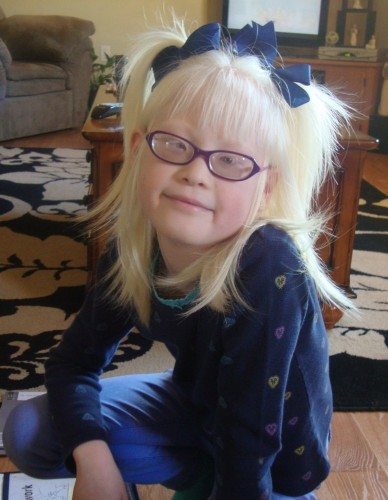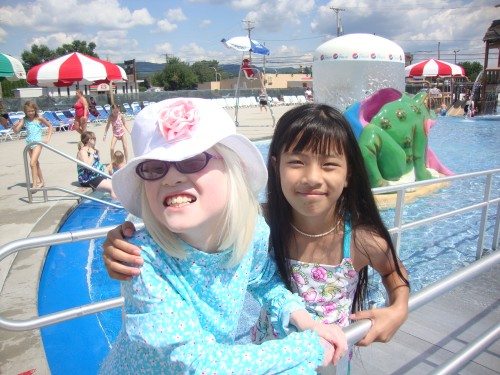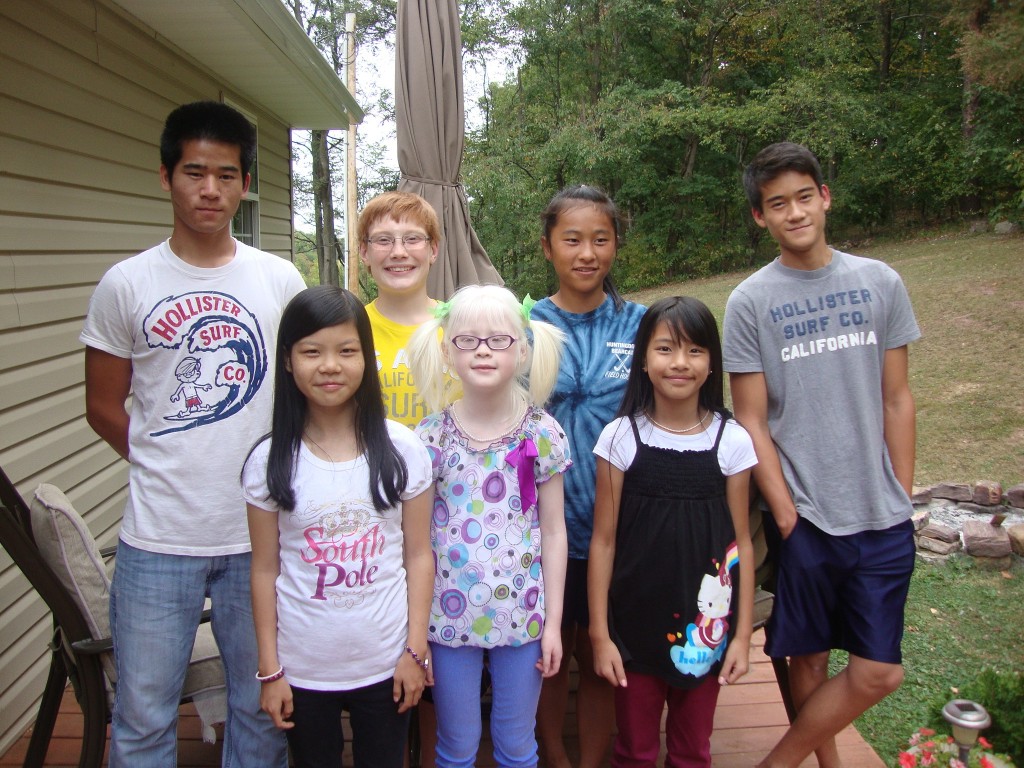Our daughter Phoebe was almost nine years old when we adopted her. She is our sixth adoptive child from China, our fifth adoption of an older child, and our first with albinism and with severe visual impairment. The only previous experience my husband and I had with visual impairments is one of our teenage daughters has nystagmus, which is when the pupils shake from side to side. It increases with fatigue, stress, nervousness, and she sometimes tilts her head to see with a better angle, but most people do not notice her eyes shaking and it does not affect her life very much. Our other adopted children had a friend from their orphanage who had albinism, so they were very comfortable with this need.
Albinism is characterized by the absence of pigment in the skin, hair and eyes, which leads to visual impairment and sensitive skin. Phoebe is very healthy, and we take her to the doctor once a year for a regular medical check. She gets through a lot of sunscreen, and we have discovered the best sunscreen combination is a spray for body and a stick for her face. It took a while to get her used to wearing sunglasses, hats and sunscreen, but we rarely forget them now. It takes about ten minutes of being in the sun with no protection before her skin starts to burn. She will often also go pink from being warm, but it’s not sunburn unless she is exposed to ultraviolet (UV) light.
When we first adopted Phoebe, I had expected to meet a child who would need to have a lot of assistance to get around, but we were surprised by how well she managed. While we were still in China, I held her hand (for bonding as well as assistance) and warned her of upcoming steps. She orients herself easily, but sometimes the depth of a step will throw her off when she is in an unfamiliar place. We were amazed to see her memorize our home layout very quickly, and once she started school she also memorized her school building and campus.
Phoebe is classified as legally blind, which means she has 20/200 vision, even with glasses on. The lack of pigmentation in her eyes as a result of her albinism hinders her vision, and there is no cure or correction for this. Most children with albinism have some visual impairment, and Phoebe’s in particular is quite severe. Our understanding is that it will not worsen over time. Phoebe also has nystagmus, quite common amongst children with albinism. As soon as we came back from China, our pediatrician referred us to a vision specialist. Four months later, and then one year later, we went back to the vision specialist to check if her glasses needed any adjustment. She now sees her vision specialist once a year. Phoebe was prescribed glasses for nearsightedness, and her doctor recommended that we purchase transition lenses to help with her sensitivity to light. These make her glasses more expensive than a regular pair of glasses, but it means that she does not need to have a separate pair of sunglasses.
Phoebe qualifies for an individual education plan (IEP). Under this, she has a vision instructor whom the school provides. Her vision instructor works with her once a week to aid her in using her vision to the best she can. This includes instruction on how to use the technology and equipment provided for her by the school, including an iPad, a video magnifier and a monocular (a small telescope).
Our greatest difficultly with the school has been the lack of understanding of how poorly Phoebe sees. As she compensates so well with using sounds, voices, size, location, and smells, she can often piece together a situation without using her vision. This can trick people into thinking she can see better than she actually can. Children will call to her across the classroom, or wave to her across the playground and she cannot see them. Kids don’t always understand that, and they think she is ignoring them. Recently, Phoebe and her visual instructor prepared and gave a presentation to her entire class to explain more about her visual impairment. They showed everyone the equipment and technology she uses and described to them what she is able to see. Her vision instructor has also offered to bring in simulation glasses to teach everyone at school what Phoebe is really able to see.
Her IEP also includes mobility instruction. She has been learning how to use a cane, and how to commute on public transport, both skills which will prove essential as she grows older. Her cane will help to identify her as a person with a visual impairment, as well as help her to gather information about her surroundings and to navigate safely. Our vision instructor tested Phoebe for her ideal font size, the best size of print so as to not fatigue her eyes, and she has her workbooks copied to that font size. She also referred us to our local Association of the Blind, and a staff member came to evaluate Phoebe and brought her a video magnifier to use at home. This is for her to use as long as she needs it, at no cost to our family.
Some parents have difficulty getting services and assistive devices for their children because their child’s vision is seen to be “too good.” As a parent, it is important to advocate for your child so that they receive the services they need to assist them in their learning. Our involvement is a yearly IEP meeting, and we keep in touch with her vision instructor via email to address any issues that come up. When Phoebe first started school, she had headaches at first from the bright lights, but after we spoke to the school about this, the administration agreed to adjust the light in her classroom slightly to solve this.
Overall, adopting a child with albinism and the visual impairment associated with albinism has been quite easy. Before we adopted her I worried that she wouldn’t be able to recognize me in a group of people. I’m not sure why that even bothered me, but it did. When we met Phoebe, I realized that I was right; she can’t tell it’s me from across the room. However, she will guess that I am in my usual chair, and she can identify where I am from the sound of my voice. I’ve learned to say “I’m right here” when we are in a crowd of people, and she finds me by listening to me call her. In reality, I didn’t need to worry about this, she knows that I am her Mama, and she knows that she can find me when she needs to.
A common occurrence among adopted children with limited vision is that they sometimes do not make eye contact well, and they may rock and have repetitive behaviors that look scary. This often also occurs in children who were orphans due to the lack of stimulation and interaction when in institutionalized care. We are working with Phoebe as she presents some behaviors such as these, reminding her to pay attention and encouraging her to watch how our other kids learn. She has to get close to us to see our expressions, which is something that didn’t occur to us before we adopted her. Phoebe is learning to look us in the eye when we speak to her, and this has helped her to interpret what our facial expressions mean. When she looks at items, she holds them just a few inches from her face, which can be awkward sometimes (particularly in a restaurant buffet!), but in general it is not a big issue.
Adopting a child with albinism has actually been a very easy special need for our family to adapt to. She functions well on a daily basis and we give her minimal assistance. As with all our kids who were adopted as older children she is immature for her age, but is rapidly catching up. She is independent in self-care, and she is able to follow our daily routine.
As a parent of older adoptive children, it has been incredible to watch the transition in our kids as they learn to have the freedom to dream. In the orphanage, they only thought about getting through each day, and now, hearing them speak of what they want to do in the future is a wonderful blessing. Phoebe has decided she wants to be a vision teacher when she grows up so that she can help children like herself. We are so excited to be her family and to walk in this journey with her. She is a wonderful child who we call our “Ray of Sunshine.” She is happy, loving and thrilled to have us as her parents and family. God led us to our daughter, and we couldn’t be more blessed by this child.
~Guest post by Vicki
For more information on adopting children who have albinism or are visually impaired visit Bethel China.





























This story is very touching. I’m happy she found a good home. I only recently found forums on albinism in China and was deeply concerned as to the future of these people. I finally found a photo of a girl in a dress in front of a window that made her look ghostly. My daughter studies Asian culture and says the color white in China is for the dead. Funerals are white, that’s why Chinese brides don’t wear white. Sad that they can’t see the beauty of the heart first. But, I’m hoping international adoption like yours will give a few a better life.